Accounting. 1. Accounting. Student Number. Class & Cour
VerifiedAdded on 2022/10/19
|17
|4072
|2
AI Summary
My australian company is Pro Medicus Ltd (PME) and my South African Company is Mediclinic International PLC
I need this assignment in one week so that i can show my tutor as my draft, and can change if needed.
Contribute Materials
Your contribution can guide someone’s learning journey. Share your
documents today.
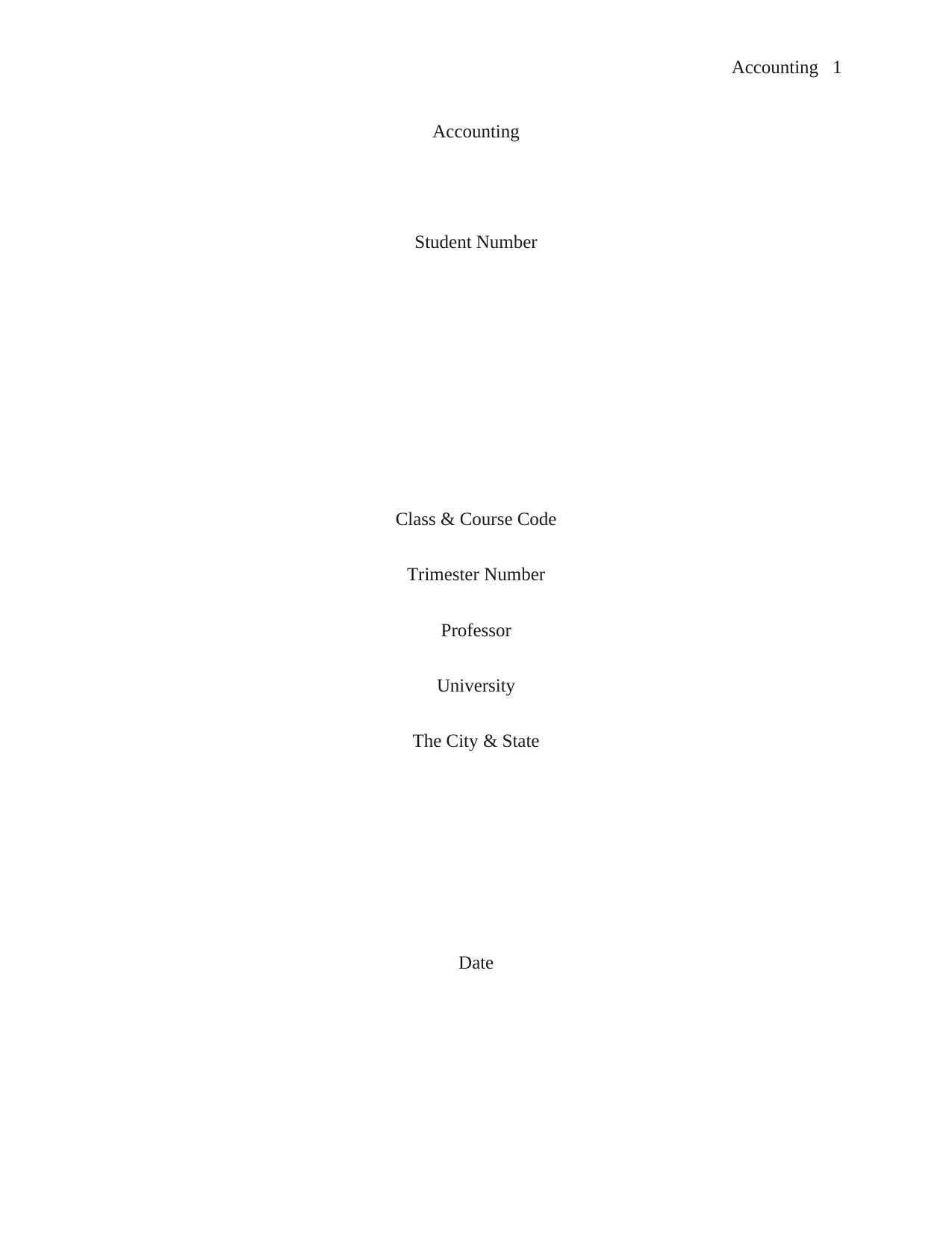
Accounting 1
Accounting
Student Number
Class & Course Code
Trimester Number
Professor
University
The City & State
Date
Accounting
Student Number
Class & Course Code
Trimester Number
Professor
University
The City & State
Date
Secure Best Marks with AI Grader
Need help grading? Try our AI Grader for instant feedback on your assignments.

Accounting 2
Executive Summary
The conceptual framework provides the company with the basis of developing accounting
standards. Before the adoption of the conceptual framework, there was no sufficient definition of
key financial elements in the balance sheet, income statement, and cash flow statements. Each of
the statements has its financial elements which are clearly defined and recognised in the
conceptual framework. The framework also outlines the qualitative characteristics of financial
reports. The reports should be relevant as well as the show as portrays the report as a faithful
representation of the company. According to 2018 annual report published by the Pro Medicus
Ltd, the company adhered to the requirement of the conceptual framework, and the Australian
corporation Act 2001. Companies are slowly turning their attention to CSR initiatives as a means
of creating value. The IIRC and the GRI have pushed for the adoption of integrated financial
reporting and sustainable financial reporting, respectively. Pro Medicus Ltd is yet to adopt either
sustainable reporting or integrate reporting within the current accounting practice globally. On
the other hand, Mediclinic International PLC engages with its stakeholders to organizational
value. Considering that CSR has become an essential part of business operations, it’s time to
adopt either sustainable reporting or integrated reporting.
Executive Summary
The conceptual framework provides the company with the basis of developing accounting
standards. Before the adoption of the conceptual framework, there was no sufficient definition of
key financial elements in the balance sheet, income statement, and cash flow statements. Each of
the statements has its financial elements which are clearly defined and recognised in the
conceptual framework. The framework also outlines the qualitative characteristics of financial
reports. The reports should be relevant as well as the show as portrays the report as a faithful
representation of the company. According to 2018 annual report published by the Pro Medicus
Ltd, the company adhered to the requirement of the conceptual framework, and the Australian
corporation Act 2001. Companies are slowly turning their attention to CSR initiatives as a means
of creating value. The IIRC and the GRI have pushed for the adoption of integrated financial
reporting and sustainable financial reporting, respectively. Pro Medicus Ltd is yet to adopt either
sustainable reporting or integrate reporting within the current accounting practice globally. On
the other hand, Mediclinic International PLC engages with its stakeholders to organizational
value. Considering that CSR has become an essential part of business operations, it’s time to
adopt either sustainable reporting or integrated reporting.
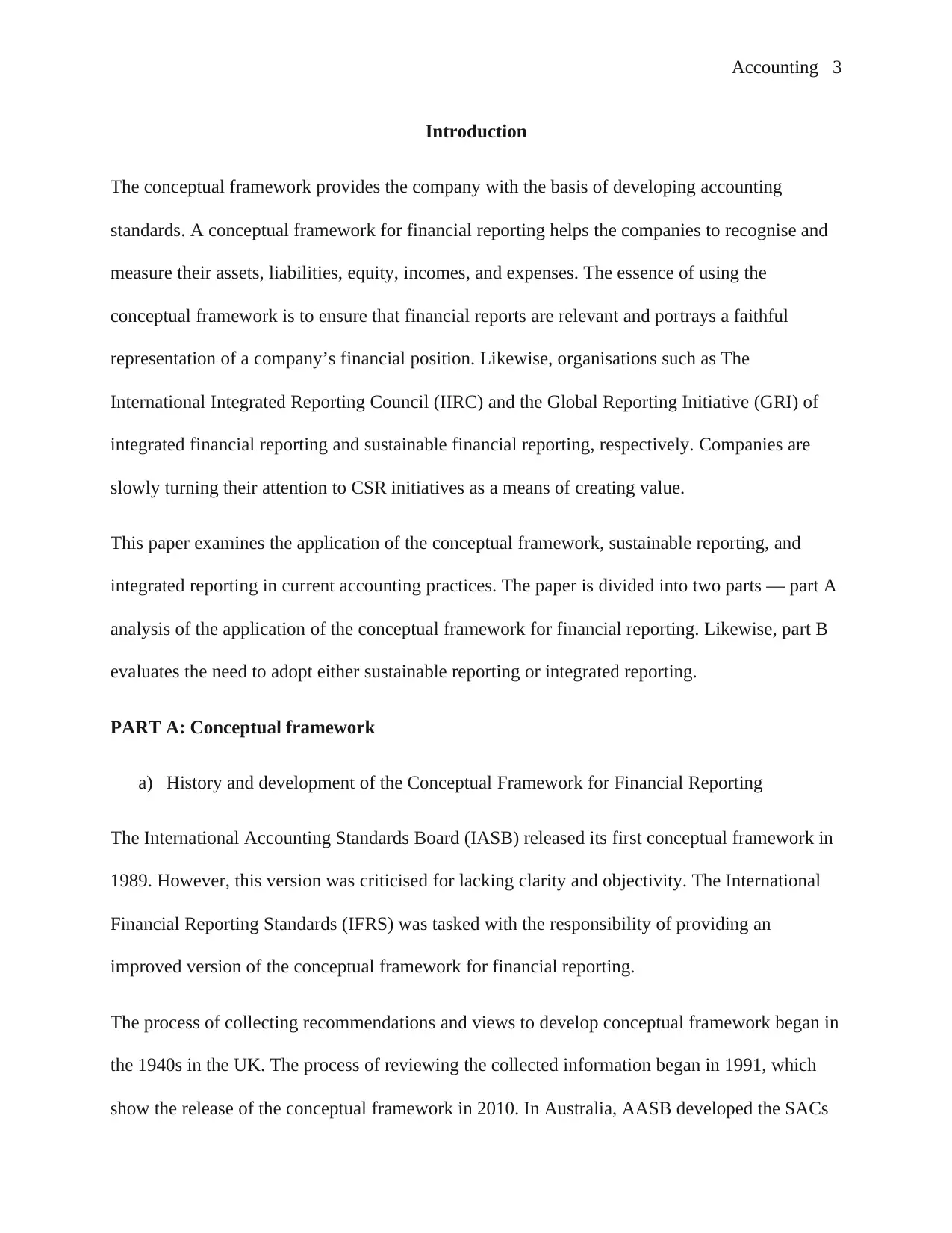
Accounting 3
Introduction
The conceptual framework provides the company with the basis of developing accounting
standards. A conceptual framework for financial reporting helps the companies to recognise and
measure their assets, liabilities, equity, incomes, and expenses. The essence of using the
conceptual framework is to ensure that financial reports are relevant and portrays a faithful
representation of a company’s financial position. Likewise, organisations such as The
International Integrated Reporting Council (IIRC) and the Global Reporting Initiative (GRI) of
integrated financial reporting and sustainable financial reporting, respectively. Companies are
slowly turning their attention to CSR initiatives as a means of creating value.
This paper examines the application of the conceptual framework, sustainable reporting, and
integrated reporting in current accounting practices. The paper is divided into two parts — part A
analysis of the application of the conceptual framework for financial reporting. Likewise, part B
evaluates the need to adopt either sustainable reporting or integrated reporting.
PART A: Conceptual framework
a) History and development of the Conceptual Framework for Financial Reporting
The International Accounting Standards Board (IASB) released its first conceptual framework in
1989. However, this version was criticised for lacking clarity and objectivity. The International
Financial Reporting Standards (IFRS) was tasked with the responsibility of providing an
improved version of the conceptual framework for financial reporting.
The process of collecting recommendations and views to develop conceptual framework began in
the 1940s in the UK. The process of reviewing the collected information began in 1991, which
show the release of the conceptual framework in 2010. In Australia, AASB developed the SACs
Introduction
The conceptual framework provides the company with the basis of developing accounting
standards. A conceptual framework for financial reporting helps the companies to recognise and
measure their assets, liabilities, equity, incomes, and expenses. The essence of using the
conceptual framework is to ensure that financial reports are relevant and portrays a faithful
representation of a company’s financial position. Likewise, organisations such as The
International Integrated Reporting Council (IIRC) and the Global Reporting Initiative (GRI) of
integrated financial reporting and sustainable financial reporting, respectively. Companies are
slowly turning their attention to CSR initiatives as a means of creating value.
This paper examines the application of the conceptual framework, sustainable reporting, and
integrated reporting in current accounting practices. The paper is divided into two parts — part A
analysis of the application of the conceptual framework for financial reporting. Likewise, part B
evaluates the need to adopt either sustainable reporting or integrated reporting.
PART A: Conceptual framework
a) History and development of the Conceptual Framework for Financial Reporting
The International Accounting Standards Board (IASB) released its first conceptual framework in
1989. However, this version was criticised for lacking clarity and objectivity. The International
Financial Reporting Standards (IFRS) was tasked with the responsibility of providing an
improved version of the conceptual framework for financial reporting.
The process of collecting recommendations and views to develop conceptual framework began in
the 1940s in the UK. The process of reviewing the collected information began in 1991, which
show the release of the conceptual framework in 2010. In Australia, AASB developed the SACs
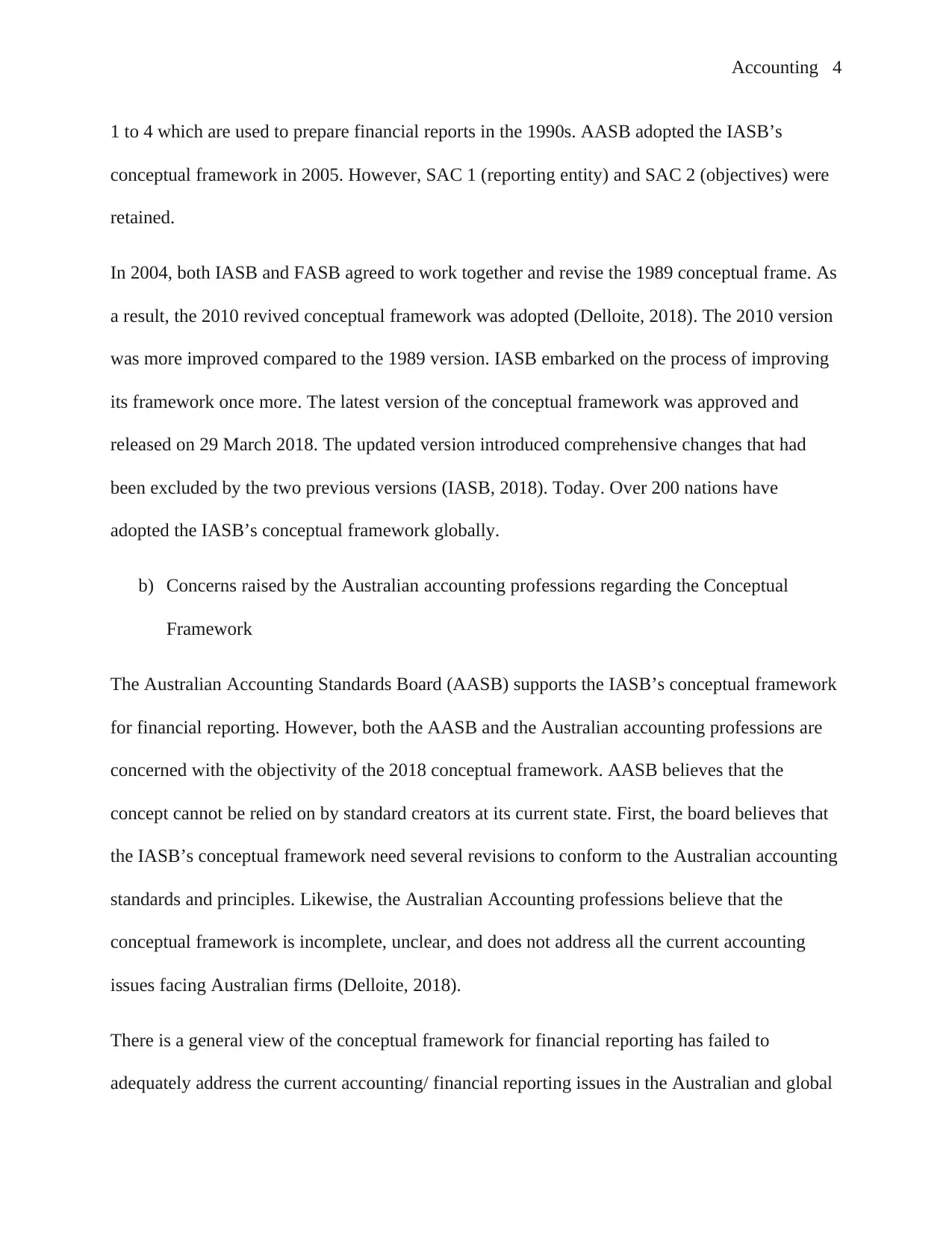
Accounting 4
1 to 4 which are used to prepare financial reports in the 1990s. AASB adopted the IASB’s
conceptual framework in 2005. However, SAC 1 (reporting entity) and SAC 2 (objectives) were
retained.
In 2004, both IASB and FASB agreed to work together and revise the 1989 conceptual frame. As
a result, the 2010 revived conceptual framework was adopted (Delloite, 2018). The 2010 version
was more improved compared to the 1989 version. IASB embarked on the process of improving
its framework once more. The latest version of the conceptual framework was approved and
released on 29 March 2018. The updated version introduced comprehensive changes that had
been excluded by the two previous versions (IASB, 2018). Today. Over 200 nations have
adopted the IASB’s conceptual framework globally.
b) Concerns raised by the Australian accounting professions regarding the Conceptual
Framework
The Australian Accounting Standards Board (AASB) supports the IASB’s conceptual framework
for financial reporting. However, both the AASB and the Australian accounting professions are
concerned with the objectivity of the 2018 conceptual framework. AASB believes that the
concept cannot be relied on by standard creators at its current state. First, the board believes that
the IASB’s conceptual framework need several revisions to conform to the Australian accounting
standards and principles. Likewise, the Australian Accounting professions believe that the
conceptual framework is incomplete, unclear, and does not address all the current accounting
issues facing Australian firms (Delloite, 2018).
There is a general view of the conceptual framework for financial reporting has failed to
adequately address the current accounting/ financial reporting issues in the Australian and global
1 to 4 which are used to prepare financial reports in the 1990s. AASB adopted the IASB’s
conceptual framework in 2005. However, SAC 1 (reporting entity) and SAC 2 (objectives) were
retained.
In 2004, both IASB and FASB agreed to work together and revise the 1989 conceptual frame. As
a result, the 2010 revived conceptual framework was adopted (Delloite, 2018). The 2010 version
was more improved compared to the 1989 version. IASB embarked on the process of improving
its framework once more. The latest version of the conceptual framework was approved and
released on 29 March 2018. The updated version introduced comprehensive changes that had
been excluded by the two previous versions (IASB, 2018). Today. Over 200 nations have
adopted the IASB’s conceptual framework globally.
b) Concerns raised by the Australian accounting professions regarding the Conceptual
Framework
The Australian Accounting Standards Board (AASB) supports the IASB’s conceptual framework
for financial reporting. However, both the AASB and the Australian accounting professions are
concerned with the objectivity of the 2018 conceptual framework. AASB believes that the
concept cannot be relied on by standard creators at its current state. First, the board believes that
the IASB’s conceptual framework need several revisions to conform to the Australian accounting
standards and principles. Likewise, the Australian Accounting professions believe that the
conceptual framework is incomplete, unclear, and does not address all the current accounting
issues facing Australian firms (Delloite, 2018).
There is a general view of the conceptual framework for financial reporting has failed to
adequately address the current accounting/ financial reporting issues in the Australian and global
Secure Best Marks with AI Grader
Need help grading? Try our AI Grader for instant feedback on your assignments.
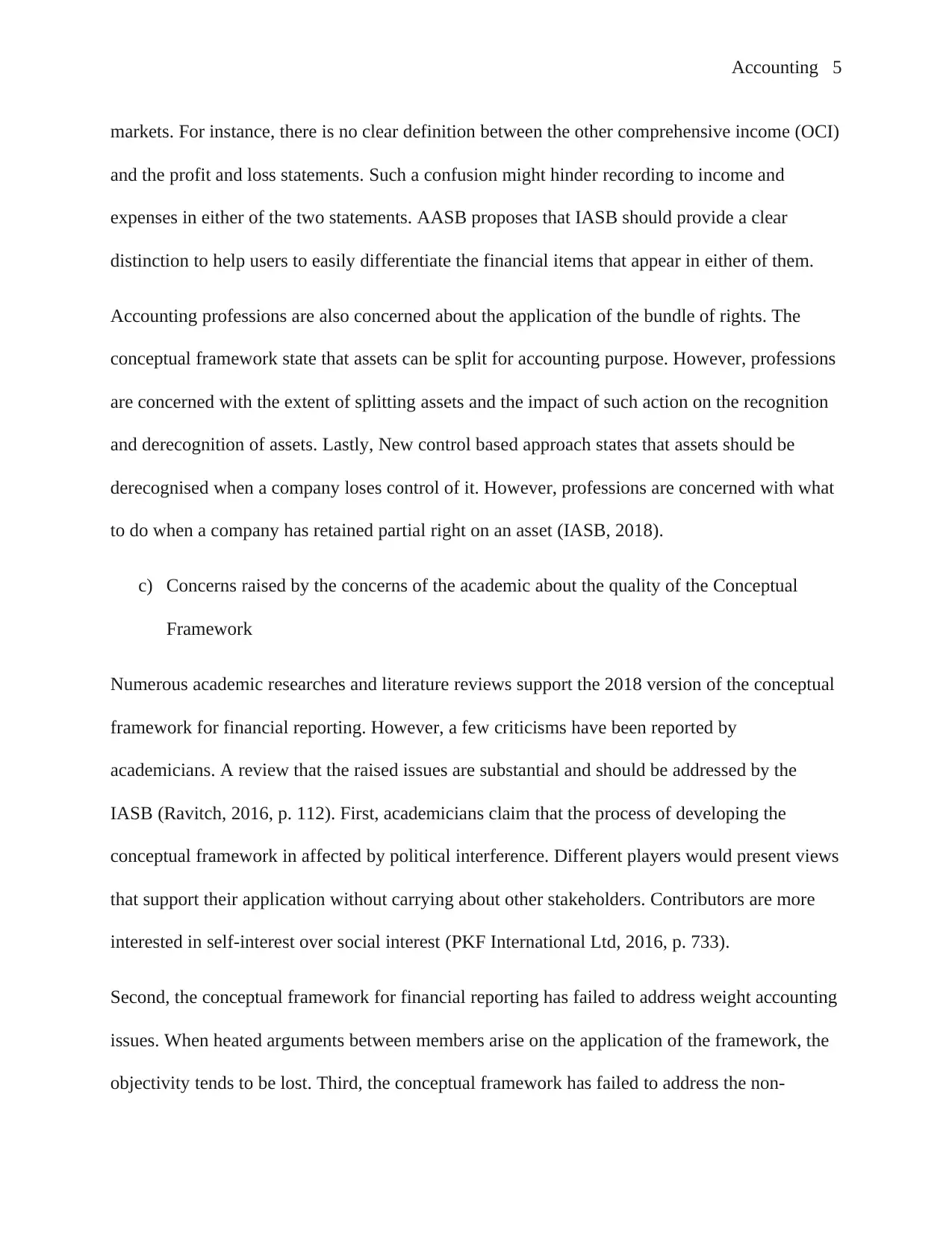
Accounting 5
markets. For instance, there is no clear definition between the other comprehensive income (OCI)
and the profit and loss statements. Such a confusion might hinder recording to income and
expenses in either of the two statements. AASB proposes that IASB should provide a clear
distinction to help users to easily differentiate the financial items that appear in either of them.
Accounting professions are also concerned about the application of the bundle of rights. The
conceptual framework state that assets can be split for accounting purpose. However, professions
are concerned with the extent of splitting assets and the impact of such action on the recognition
and derecognition of assets. Lastly, New control based approach states that assets should be
derecognised when a company loses control of it. However, professions are concerned with what
to do when a company has retained partial right on an asset (IASB, 2018).
c) Concerns raised by the concerns of the academic about the quality of the Conceptual
Framework
Numerous academic researches and literature reviews support the 2018 version of the conceptual
framework for financial reporting. However, a few criticisms have been reported by
academicians. A review that the raised issues are substantial and should be addressed by the
IASB (Ravitch, 2016, p. 112). First, academicians claim that the process of developing the
conceptual framework in affected by political interference. Different players would present views
that support their application without carrying about other stakeholders. Contributors are more
interested in self-interest over social interest (PKF International Ltd, 2016, p. 733).
Second, the conceptual framework for financial reporting has failed to address weight accounting
issues. When heated arguments between members arise on the application of the framework, the
objectivity tends to be lost. Third, the conceptual framework has failed to address the non-
markets. For instance, there is no clear definition between the other comprehensive income (OCI)
and the profit and loss statements. Such a confusion might hinder recording to income and
expenses in either of the two statements. AASB proposes that IASB should provide a clear
distinction to help users to easily differentiate the financial items that appear in either of them.
Accounting professions are also concerned about the application of the bundle of rights. The
conceptual framework state that assets can be split for accounting purpose. However, professions
are concerned with the extent of splitting assets and the impact of such action on the recognition
and derecognition of assets. Lastly, New control based approach states that assets should be
derecognised when a company loses control of it. However, professions are concerned with what
to do when a company has retained partial right on an asset (IASB, 2018).
c) Concerns raised by the concerns of the academic about the quality of the Conceptual
Framework
Numerous academic researches and literature reviews support the 2018 version of the conceptual
framework for financial reporting. However, a few criticisms have been reported by
academicians. A review that the raised issues are substantial and should be addressed by the
IASB (Ravitch, 2016, p. 112). First, academicians claim that the process of developing the
conceptual framework in affected by political interference. Different players would present views
that support their application without carrying about other stakeholders. Contributors are more
interested in self-interest over social interest (PKF International Ltd, 2016, p. 733).
Second, the conceptual framework for financial reporting has failed to address weight accounting
issues. When heated arguments between members arise on the application of the framework, the
objectivity tends to be lost. Third, the conceptual framework has failed to address the non-

Accounting 6
performance aspect of business entities (Macve, 2015, p. 79). Fourth, the process of complying
with the conceptual framework is costly for small businesses. Fifth, the framework is considered
ambiguous because it is open to interpretation. Lastly, principles under the conceptual framework
are vague; they describe accounting practices without providing remedies to current accounting
issues (Hussey & Ong, 2017, p. 201).
d) How Pro Medicus Ltd (ASX: PME) apply a conceptual framework to prepare its annual
reports
AASB states that the conceptual framework for financial reporting should guide the public listed
companies in Australia. This section reviews the application of the framework by the Pro
Medicus Ltd to prepare its 2018 financial statements.
(i) Financial components used by Pro Medicus to prepare its financial statement
The conceptual framework for financial reporting states that an annual report must contain
several financial statements to be considered relevant and a faithful representation of an
organisation. The recognised financial statements under the conceptual frame and the AASB’s
SAC 3 are;
a) The balance sheet which comprises of financial elements such as asset, liabilities, and
capital,
b) The income statement which comprises of income and expense financial elements,
c) The cash flow statement is made up of operating, investment, and capital activities of a
business.
d) Other comprehensive income (OCI) statement, which comprises of the changes in the
income and expense financial elements (Pro Medicus Ltd, 2019, p. 45).
performance aspect of business entities (Macve, 2015, p. 79). Fourth, the process of complying
with the conceptual framework is costly for small businesses. Fifth, the framework is considered
ambiguous because it is open to interpretation. Lastly, principles under the conceptual framework
are vague; they describe accounting practices without providing remedies to current accounting
issues (Hussey & Ong, 2017, p. 201).
d) How Pro Medicus Ltd (ASX: PME) apply a conceptual framework to prepare its annual
reports
AASB states that the conceptual framework for financial reporting should guide the public listed
companies in Australia. This section reviews the application of the framework by the Pro
Medicus Ltd to prepare its 2018 financial statements.
(i) Financial components used by Pro Medicus to prepare its financial statement
The conceptual framework for financial reporting states that an annual report must contain
several financial statements to be considered relevant and a faithful representation of an
organisation. The recognised financial statements under the conceptual frame and the AASB’s
SAC 3 are;
a) The balance sheet which comprises of financial elements such as asset, liabilities, and
capital,
b) The income statement which comprises of income and expense financial elements,
c) The cash flow statement is made up of operating, investment, and capital activities of a
business.
d) Other comprehensive income (OCI) statement, which comprises of the changes in the
income and expense financial elements (Pro Medicus Ltd, 2019, p. 45).
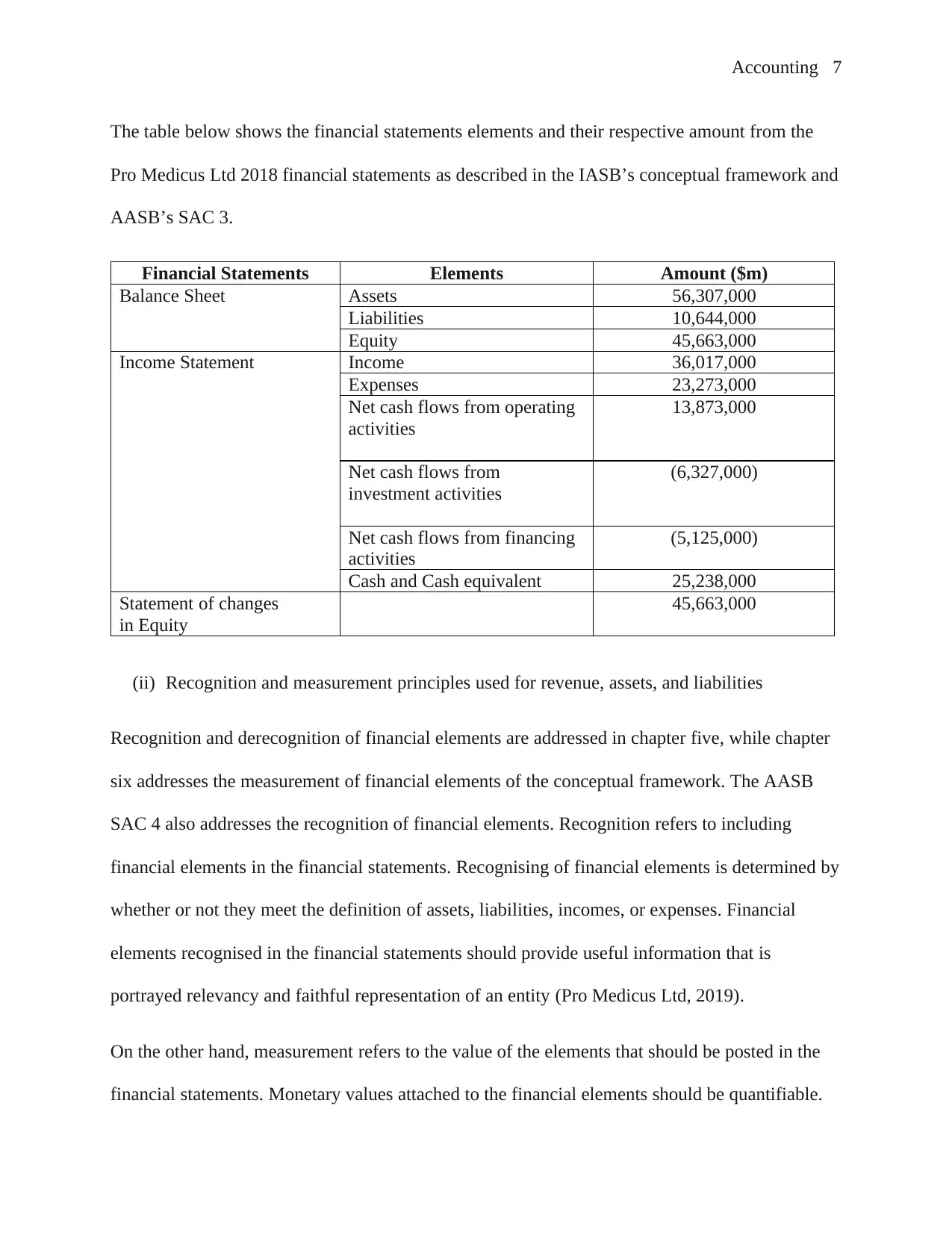
Accounting 7
The table below shows the financial statements elements and their respective amount from the
Pro Medicus Ltd 2018 financial statements as described in the IASB’s conceptual framework and
AASB’s SAC 3.
Financial Statements Elements Amount ($m)
Balance Sheet Assets 56,307,000
Liabilities 10,644,000
Equity 45,663,000
Income Statement Income 36,017,000
Expenses 23,273,000
Net cash flows from operating
activities
13,873,000
Net cash flows from
investment activities
(6,327,000)
Net cash flows from financing
activities
(5,125,000)
Cash and Cash equivalent 25,238,000
Statement of changes
in Equity
45,663,000
(ii) Recognition and measurement principles used for revenue, assets, and liabilities
Recognition and derecognition of financial elements are addressed in chapter five, while chapter
six addresses the measurement of financial elements of the conceptual framework. The AASB
SAC 4 also addresses the recognition of financial elements. Recognition refers to including
financial elements in the financial statements. Recognising of financial elements is determined by
whether or not they meet the definition of assets, liabilities, incomes, or expenses. Financial
elements recognised in the financial statements should provide useful information that is
portrayed relevancy and faithful representation of an entity (Pro Medicus Ltd, 2019).
On the other hand, measurement refers to the value of the elements that should be posted in the
financial statements. Monetary values attached to the financial elements should be quantifiable.
The table below shows the financial statements elements and their respective amount from the
Pro Medicus Ltd 2018 financial statements as described in the IASB’s conceptual framework and
AASB’s SAC 3.
Financial Statements Elements Amount ($m)
Balance Sheet Assets 56,307,000
Liabilities 10,644,000
Equity 45,663,000
Income Statement Income 36,017,000
Expenses 23,273,000
Net cash flows from operating
activities
13,873,000
Net cash flows from
investment activities
(6,327,000)
Net cash flows from financing
activities
(5,125,000)
Cash and Cash equivalent 25,238,000
Statement of changes
in Equity
45,663,000
(ii) Recognition and measurement principles used for revenue, assets, and liabilities
Recognition and derecognition of financial elements are addressed in chapter five, while chapter
six addresses the measurement of financial elements of the conceptual framework. The AASB
SAC 4 also addresses the recognition of financial elements. Recognition refers to including
financial elements in the financial statements. Recognising of financial elements is determined by
whether or not they meet the definition of assets, liabilities, incomes, or expenses. Financial
elements recognised in the financial statements should provide useful information that is
portrayed relevancy and faithful representation of an entity (Pro Medicus Ltd, 2019).
On the other hand, measurement refers to the value of the elements that should be posted in the
financial statements. Monetary values attached to the financial elements should be quantifiable.
Paraphrase This Document
Need a fresh take? Get an instant paraphrase of this document with our AI Paraphraser
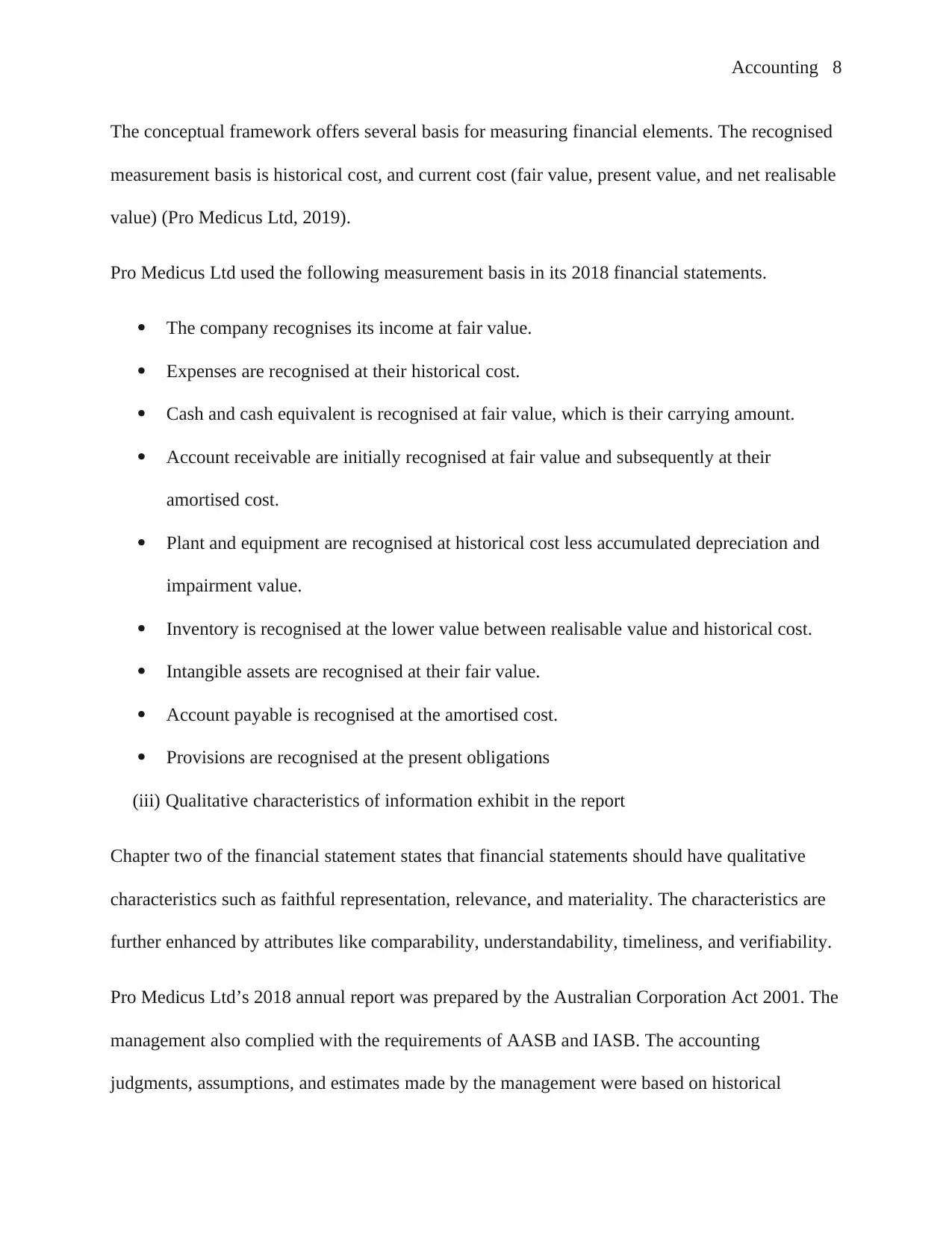
Accounting 8
The conceptual framework offers several basis for measuring financial elements. The recognised
measurement basis is historical cost, and current cost (fair value, present value, and net realisable
value) (Pro Medicus Ltd, 2019).
Pro Medicus Ltd used the following measurement basis in its 2018 financial statements.
The company recognises its income at fair value.
Expenses are recognised at their historical cost.
Cash and cash equivalent is recognised at fair value, which is their carrying amount.
Account receivable are initially recognised at fair value and subsequently at their
amortised cost.
Plant and equipment are recognised at historical cost less accumulated depreciation and
impairment value.
Inventory is recognised at the lower value between realisable value and historical cost.
Intangible assets are recognised at their fair value.
Account payable is recognised at the amortised cost.
Provisions are recognised at the present obligations
(iii) Qualitative characteristics of information exhibit in the report
Chapter two of the financial statement states that financial statements should have qualitative
characteristics such as faithful representation, relevance, and materiality. The characteristics are
further enhanced by attributes like comparability, understandability, timeliness, and verifiability.
Pro Medicus Ltd’s 2018 annual report was prepared by the Australian Corporation Act 2001. The
management also complied with the requirements of AASB and IASB. The accounting
judgments, assumptions, and estimates made by the management were based on historical
The conceptual framework offers several basis for measuring financial elements. The recognised
measurement basis is historical cost, and current cost (fair value, present value, and net realisable
value) (Pro Medicus Ltd, 2019).
Pro Medicus Ltd used the following measurement basis in its 2018 financial statements.
The company recognises its income at fair value.
Expenses are recognised at their historical cost.
Cash and cash equivalent is recognised at fair value, which is their carrying amount.
Account receivable are initially recognised at fair value and subsequently at their
amortised cost.
Plant and equipment are recognised at historical cost less accumulated depreciation and
impairment value.
Inventory is recognised at the lower value between realisable value and historical cost.
Intangible assets are recognised at their fair value.
Account payable is recognised at the amortised cost.
Provisions are recognised at the present obligations
(iii) Qualitative characteristics of information exhibit in the report
Chapter two of the financial statement states that financial statements should have qualitative
characteristics such as faithful representation, relevance, and materiality. The characteristics are
further enhanced by attributes like comparability, understandability, timeliness, and verifiability.
Pro Medicus Ltd’s 2018 annual report was prepared by the Australian Corporation Act 2001. The
management also complied with the requirements of AASB and IASB. The accounting
judgments, assumptions, and estimates made by the management were based on historical
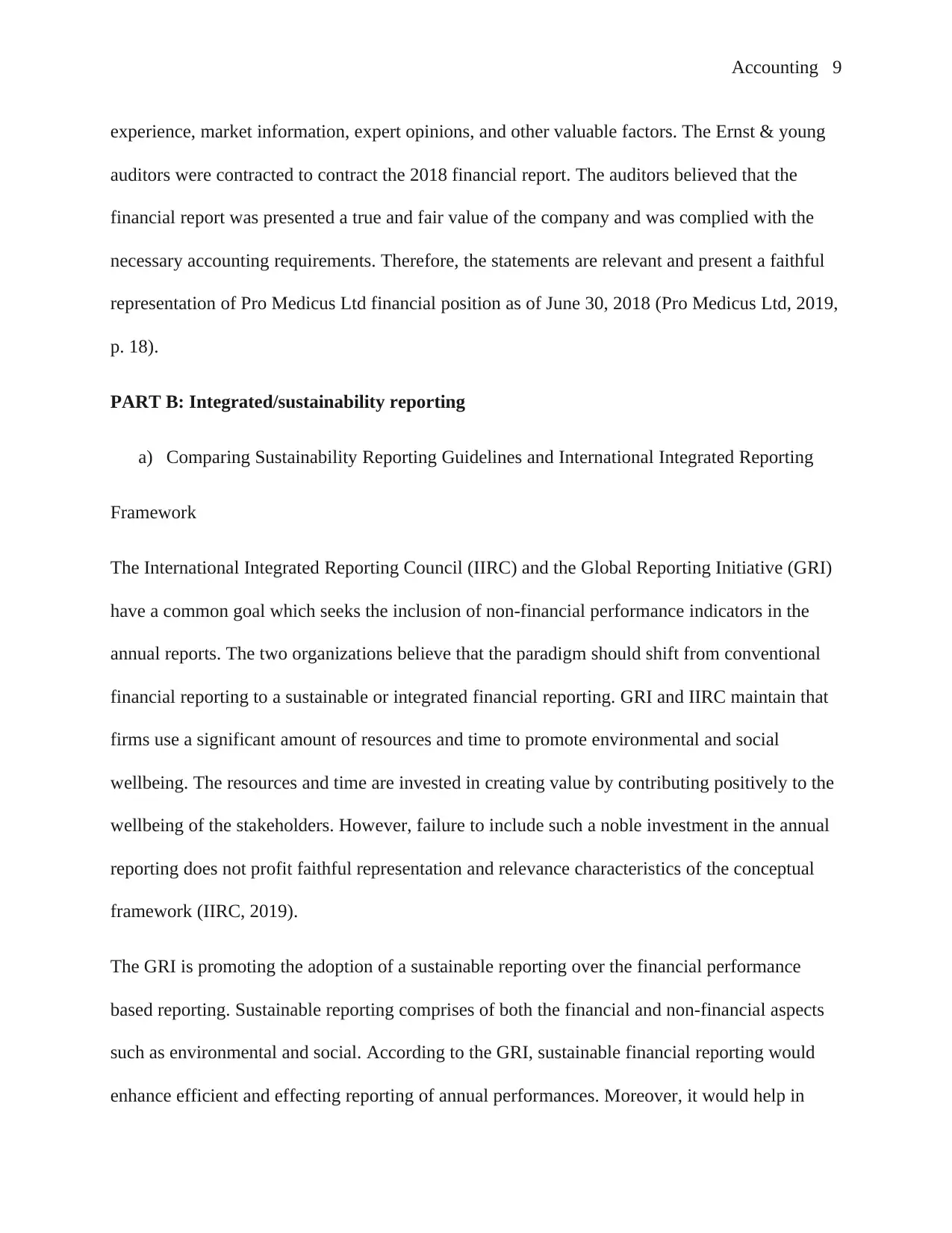
Accounting 9
experience, market information, expert opinions, and other valuable factors. The Ernst & young
auditors were contracted to contract the 2018 financial report. The auditors believed that the
financial report was presented a true and fair value of the company and was complied with the
necessary accounting requirements. Therefore, the statements are relevant and present a faithful
representation of Pro Medicus Ltd financial position as of June 30, 2018 (Pro Medicus Ltd, 2019,
p. 18).
PART B: Integrated/sustainability reporting
a) Comparing Sustainability Reporting Guidelines and International Integrated Reporting
Framework
The International Integrated Reporting Council (IIRC) and the Global Reporting Initiative (GRI)
have a common goal which seeks the inclusion of non-financial performance indicators in the
annual reports. The two organizations believe that the paradigm should shift from conventional
financial reporting to a sustainable or integrated financial reporting. GRI and IIRC maintain that
firms use a significant amount of resources and time to promote environmental and social
wellbeing. The resources and time are invested in creating value by contributing positively to the
wellbeing of the stakeholders. However, failure to include such a noble investment in the annual
reporting does not profit faithful representation and relevance characteristics of the conceptual
framework (IIRC, 2019).
The GRI is promoting the adoption of a sustainable reporting over the financial performance
based reporting. Sustainable reporting comprises of both the financial and non-financial aspects
such as environmental and social. According to the GRI, sustainable financial reporting would
enhance efficient and effecting reporting of annual performances. Moreover, it would help in
experience, market information, expert opinions, and other valuable factors. The Ernst & young
auditors were contracted to contract the 2018 financial report. The auditors believed that the
financial report was presented a true and fair value of the company and was complied with the
necessary accounting requirements. Therefore, the statements are relevant and present a faithful
representation of Pro Medicus Ltd financial position as of June 30, 2018 (Pro Medicus Ltd, 2019,
p. 18).
PART B: Integrated/sustainability reporting
a) Comparing Sustainability Reporting Guidelines and International Integrated Reporting
Framework
The International Integrated Reporting Council (IIRC) and the Global Reporting Initiative (GRI)
have a common goal which seeks the inclusion of non-financial performance indicators in the
annual reports. The two organizations believe that the paradigm should shift from conventional
financial reporting to a sustainable or integrated financial reporting. GRI and IIRC maintain that
firms use a significant amount of resources and time to promote environmental and social
wellbeing. The resources and time are invested in creating value by contributing positively to the
wellbeing of the stakeholders. However, failure to include such a noble investment in the annual
reporting does not profit faithful representation and relevance characteristics of the conceptual
framework (IIRC, 2019).
The GRI is promoting the adoption of a sustainable reporting over the financial performance
based reporting. Sustainable reporting comprises of both the financial and non-financial aspects
such as environmental and social. According to the GRI, sustainable financial reporting would
enhance efficient and effecting reporting of annual performances. Moreover, it would help in
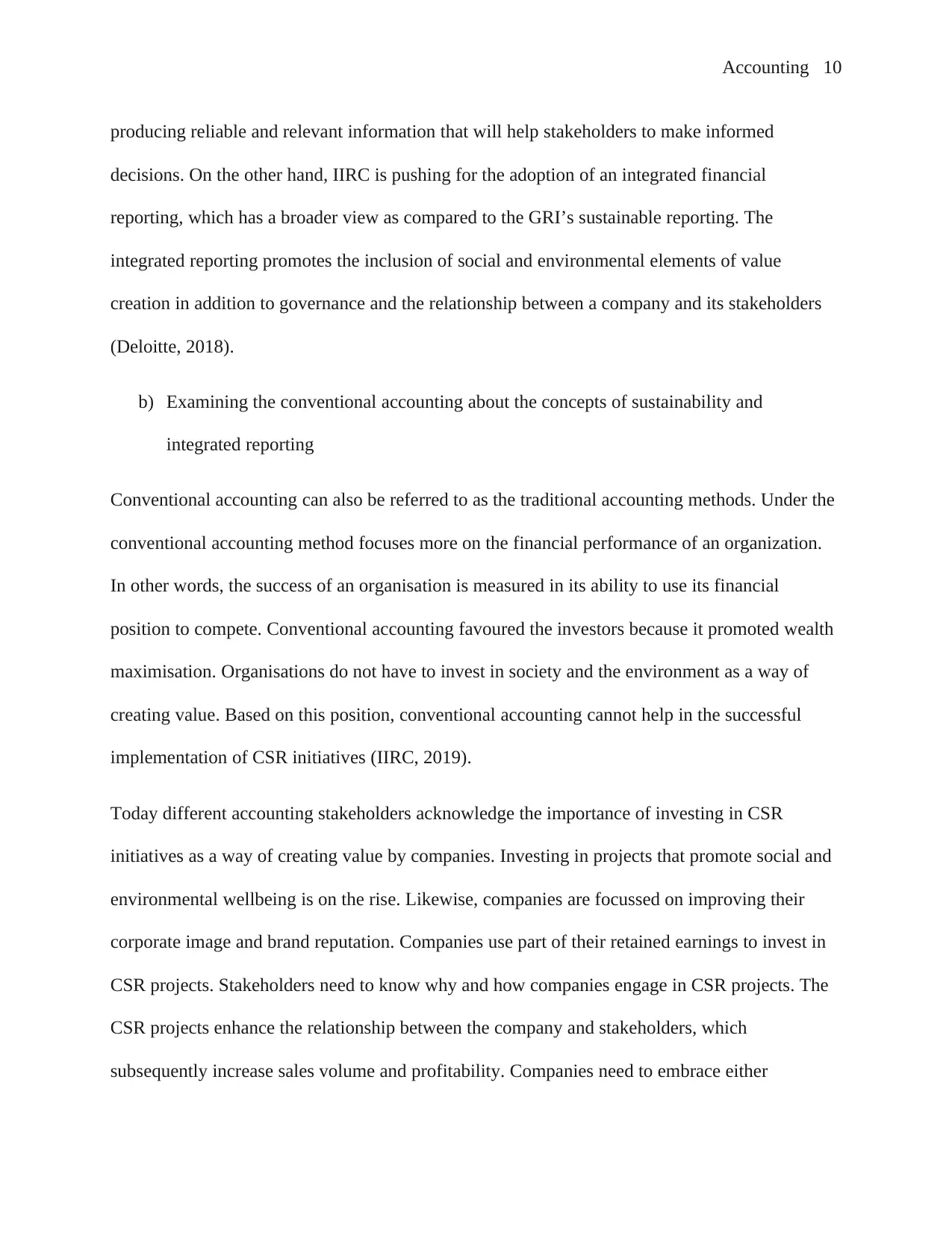
Accounting 10
producing reliable and relevant information that will help stakeholders to make informed
decisions. On the other hand, IIRC is pushing for the adoption of an integrated financial
reporting, which has a broader view as compared to the GRI’s sustainable reporting. The
integrated reporting promotes the inclusion of social and environmental elements of value
creation in addition to governance and the relationship between a company and its stakeholders
(Deloitte, 2018).
b) Examining the conventional accounting about the concepts of sustainability and
integrated reporting
Conventional accounting can also be referred to as the traditional accounting methods. Under the
conventional accounting method focuses more on the financial performance of an organization.
In other words, the success of an organisation is measured in its ability to use its financial
position to compete. Conventional accounting favoured the investors because it promoted wealth
maximisation. Organisations do not have to invest in society and the environment as a way of
creating value. Based on this position, conventional accounting cannot help in the successful
implementation of CSR initiatives (IIRC, 2019).
Today different accounting stakeholders acknowledge the importance of investing in CSR
initiatives as a way of creating value by companies. Investing in projects that promote social and
environmental wellbeing is on the rise. Likewise, companies are focussed on improving their
corporate image and brand reputation. Companies use part of their retained earnings to invest in
CSR projects. Stakeholders need to know why and how companies engage in CSR projects. The
CSR projects enhance the relationship between the company and stakeholders, which
subsequently increase sales volume and profitability. Companies need to embrace either
producing reliable and relevant information that will help stakeholders to make informed
decisions. On the other hand, IIRC is pushing for the adoption of an integrated financial
reporting, which has a broader view as compared to the GRI’s sustainable reporting. The
integrated reporting promotes the inclusion of social and environmental elements of value
creation in addition to governance and the relationship between a company and its stakeholders
(Deloitte, 2018).
b) Examining the conventional accounting about the concepts of sustainability and
integrated reporting
Conventional accounting can also be referred to as the traditional accounting methods. Under the
conventional accounting method focuses more on the financial performance of an organization.
In other words, the success of an organisation is measured in its ability to use its financial
position to compete. Conventional accounting favoured the investors because it promoted wealth
maximisation. Organisations do not have to invest in society and the environment as a way of
creating value. Based on this position, conventional accounting cannot help in the successful
implementation of CSR initiatives (IIRC, 2019).
Today different accounting stakeholders acknowledge the importance of investing in CSR
initiatives as a way of creating value by companies. Investing in projects that promote social and
environmental wellbeing is on the rise. Likewise, companies are focussed on improving their
corporate image and brand reputation. Companies use part of their retained earnings to invest in
CSR projects. Stakeholders need to know why and how companies engage in CSR projects. The
CSR projects enhance the relationship between the company and stakeholders, which
subsequently increase sales volume and profitability. Companies need to embrace either
Secure Best Marks with AI Grader
Need help grading? Try our AI Grader for instant feedback on your assignments.
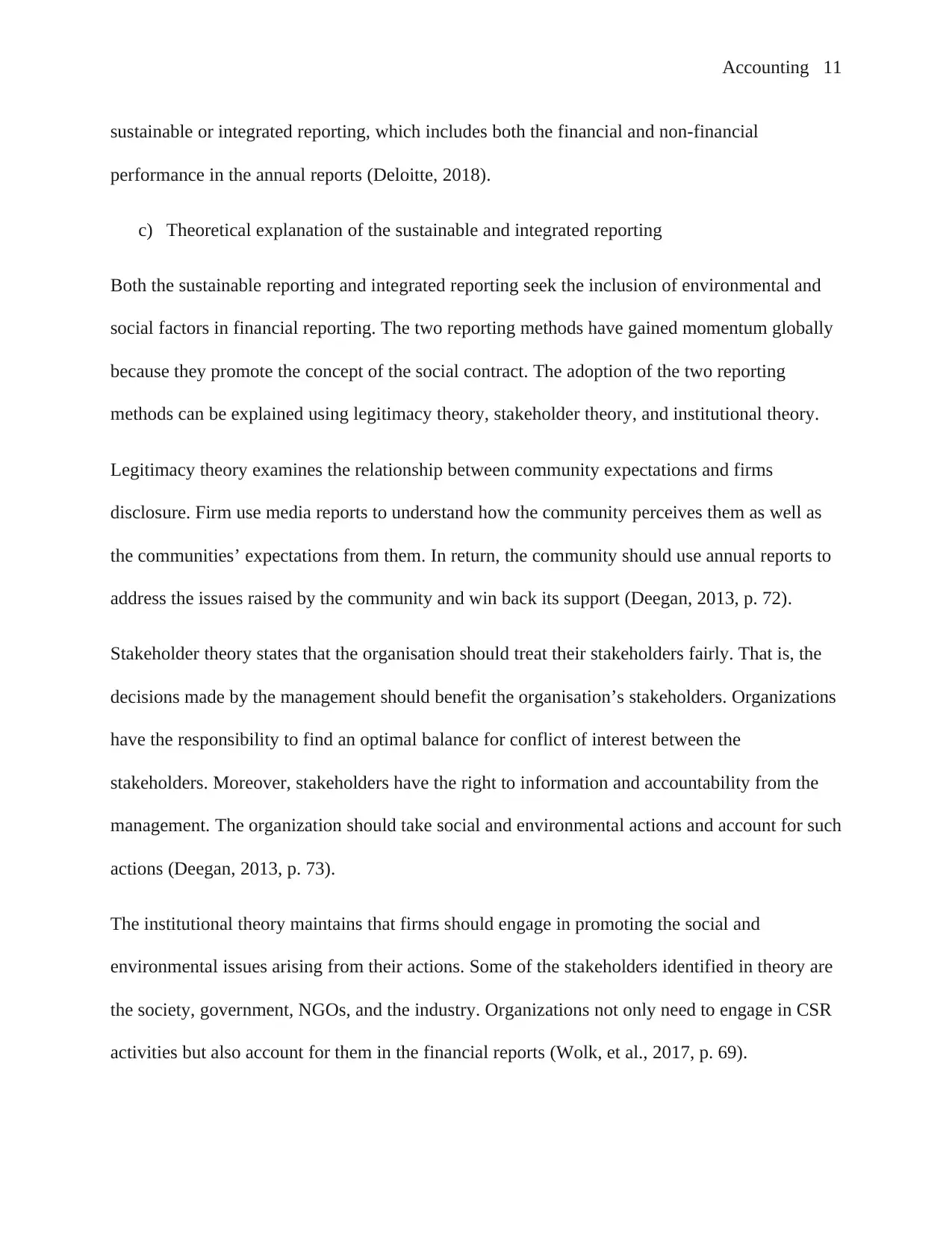
Accounting 11
sustainable or integrated reporting, which includes both the financial and non-financial
performance in the annual reports (Deloitte, 2018).
c) Theoretical explanation of the sustainable and integrated reporting
Both the sustainable reporting and integrated reporting seek the inclusion of environmental and
social factors in financial reporting. The two reporting methods have gained momentum globally
because they promote the concept of the social contract. The adoption of the two reporting
methods can be explained using legitimacy theory, stakeholder theory, and institutional theory.
Legitimacy theory examines the relationship between community expectations and firms
disclosure. Firm use media reports to understand how the community perceives them as well as
the communities’ expectations from them. In return, the community should use annual reports to
address the issues raised by the community and win back its support (Deegan, 2013, p. 72).
Stakeholder theory states that the organisation should treat their stakeholders fairly. That is, the
decisions made by the management should benefit the organisation’s stakeholders. Organizations
have the responsibility to find an optimal balance for conflict of interest between the
stakeholders. Moreover, stakeholders have the right to information and accountability from the
management. The organization should take social and environmental actions and account for such
actions (Deegan, 2013, p. 73).
The institutional theory maintains that firms should engage in promoting the social and
environmental issues arising from their actions. Some of the stakeholders identified in theory are
the society, government, NGOs, and the industry. Organizations not only need to engage in CSR
activities but also account for them in the financial reports (Wolk, et al., 2017, p. 69).
sustainable or integrated reporting, which includes both the financial and non-financial
performance in the annual reports (Deloitte, 2018).
c) Theoretical explanation of the sustainable and integrated reporting
Both the sustainable reporting and integrated reporting seek the inclusion of environmental and
social factors in financial reporting. The two reporting methods have gained momentum globally
because they promote the concept of the social contract. The adoption of the two reporting
methods can be explained using legitimacy theory, stakeholder theory, and institutional theory.
Legitimacy theory examines the relationship between community expectations and firms
disclosure. Firm use media reports to understand how the community perceives them as well as
the communities’ expectations from them. In return, the community should use annual reports to
address the issues raised by the community and win back its support (Deegan, 2013, p. 72).
Stakeholder theory states that the organisation should treat their stakeholders fairly. That is, the
decisions made by the management should benefit the organisation’s stakeholders. Organizations
have the responsibility to find an optimal balance for conflict of interest between the
stakeholders. Moreover, stakeholders have the right to information and accountability from the
management. The organization should take social and environmental actions and account for such
actions (Deegan, 2013, p. 73).
The institutional theory maintains that firms should engage in promoting the social and
environmental issues arising from their actions. Some of the stakeholders identified in theory are
the society, government, NGOs, and the industry. Organizations not only need to engage in CSR
activities but also account for them in the financial reports (Wolk, et al., 2017, p. 69).
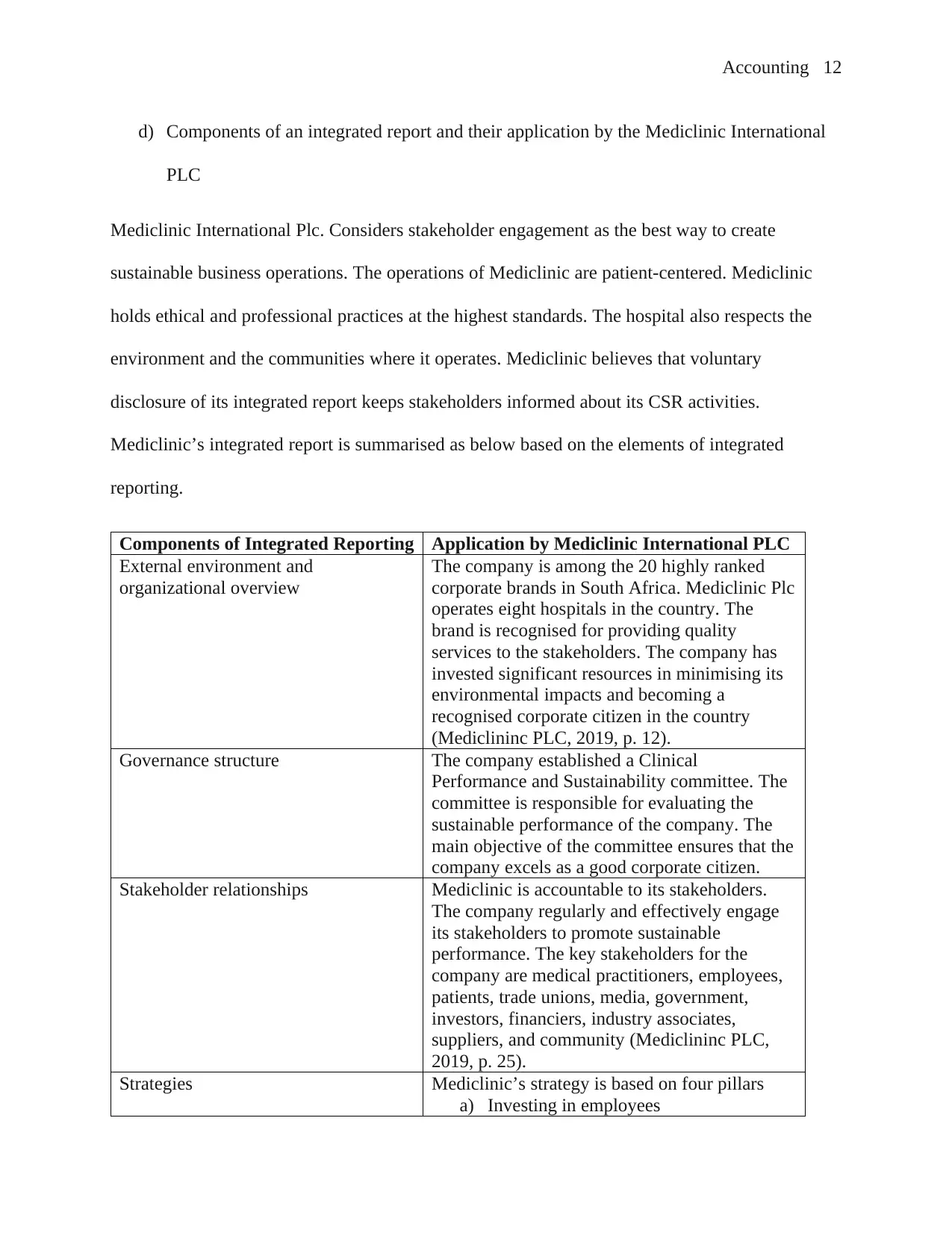
Accounting 12
d) Components of an integrated report and their application by the Mediclinic International
PLC
Mediclinic International Plc. Considers stakeholder engagement as the best way to create
sustainable business operations. The operations of Mediclinic are patient-centered. Mediclinic
holds ethical and professional practices at the highest standards. The hospital also respects the
environment and the communities where it operates. Mediclinic believes that voluntary
disclosure of its integrated report keeps stakeholders informed about its CSR activities.
Mediclinic’s integrated report is summarised as below based on the elements of integrated
reporting.
Components of Integrated Reporting Application by Mediclinic International PLC
External environment and
organizational overview
The company is among the 20 highly ranked
corporate brands in South Africa. Mediclinic Plc
operates eight hospitals in the country. The
brand is recognised for providing quality
services to the stakeholders. The company has
invested significant resources in minimising its
environmental impacts and becoming a
recognised corporate citizen in the country
(Mediclininc PLC, 2019, p. 12).
Governance structure The company established a Clinical
Performance and Sustainability committee. The
committee is responsible for evaluating the
sustainable performance of the company. The
main objective of the committee ensures that the
company excels as a good corporate citizen.
Stakeholder relationships Mediclinic is accountable to its stakeholders.
The company regularly and effectively engage
its stakeholders to promote sustainable
performance. The key stakeholders for the
company are medical practitioners, employees,
patients, trade unions, media, government,
investors, financiers, industry associates,
suppliers, and community (Mediclininc PLC,
2019, p. 25).
Strategies Mediclinic’s strategy is based on four pillars
a) Investing in employees
d) Components of an integrated report and their application by the Mediclinic International
PLC
Mediclinic International Plc. Considers stakeholder engagement as the best way to create
sustainable business operations. The operations of Mediclinic are patient-centered. Mediclinic
holds ethical and professional practices at the highest standards. The hospital also respects the
environment and the communities where it operates. Mediclinic believes that voluntary
disclosure of its integrated report keeps stakeholders informed about its CSR activities.
Mediclinic’s integrated report is summarised as below based on the elements of integrated
reporting.
Components of Integrated Reporting Application by Mediclinic International PLC
External environment and
organizational overview
The company is among the 20 highly ranked
corporate brands in South Africa. Mediclinic Plc
operates eight hospitals in the country. The
brand is recognised for providing quality
services to the stakeholders. The company has
invested significant resources in minimising its
environmental impacts and becoming a
recognised corporate citizen in the country
(Mediclininc PLC, 2019, p. 12).
Governance structure The company established a Clinical
Performance and Sustainability committee. The
committee is responsible for evaluating the
sustainable performance of the company. The
main objective of the committee ensures that the
company excels as a good corporate citizen.
Stakeholder relationships Mediclinic is accountable to its stakeholders.
The company regularly and effectively engage
its stakeholders to promote sustainable
performance. The key stakeholders for the
company are medical practitioners, employees,
patients, trade unions, media, government,
investors, financiers, industry associates,
suppliers, and community (Mediclininc PLC,
2019, p. 25).
Strategies Mediclinic’s strategy is based on four pillars
a) Investing in employees
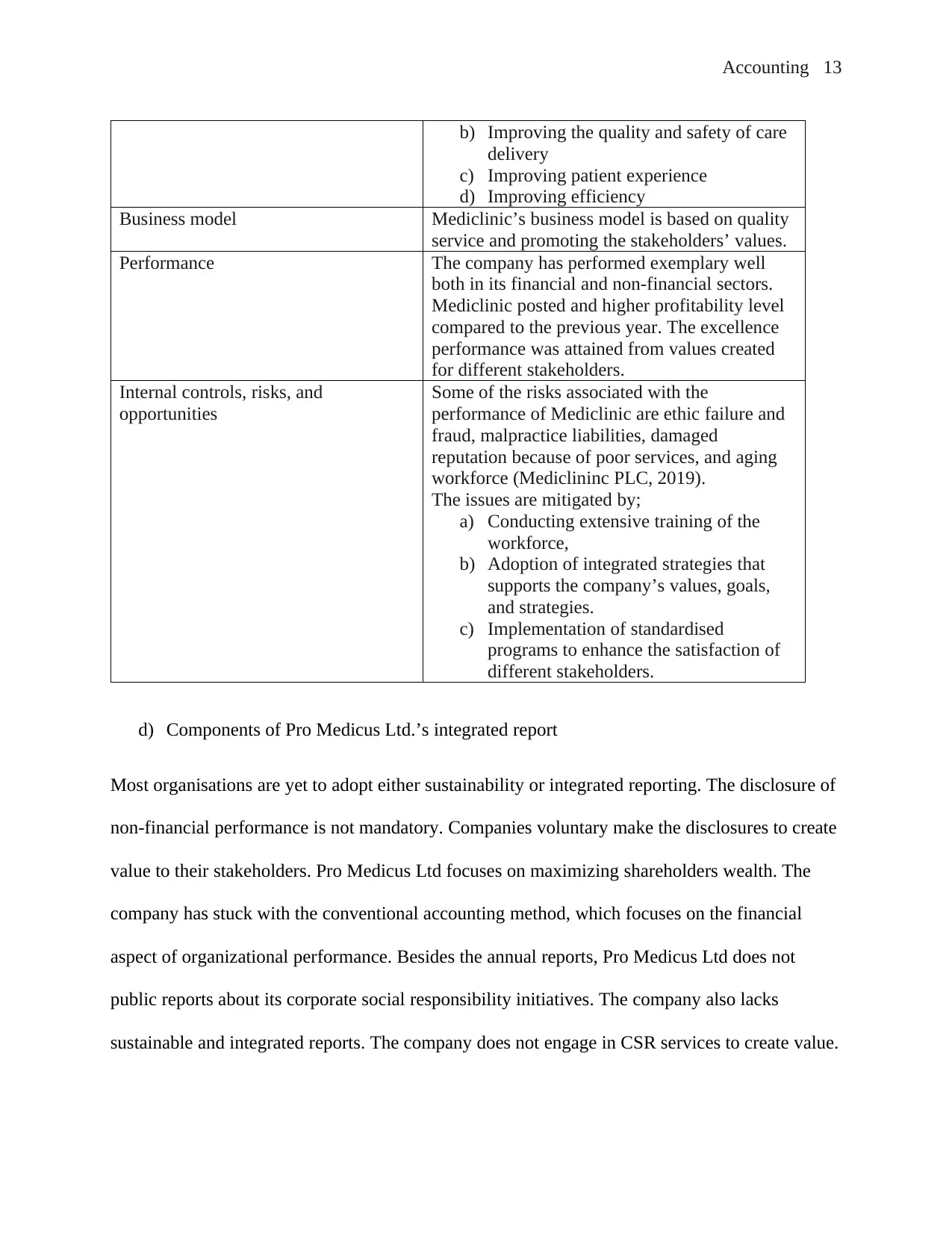
Accounting 13
b) Improving the quality and safety of care
delivery
c) Improving patient experience
d) Improving efficiency
Business model Mediclinic’s business model is based on quality
service and promoting the stakeholders’ values.
Performance The company has performed exemplary well
both in its financial and non-financial sectors.
Mediclinic posted and higher profitability level
compared to the previous year. The excellence
performance was attained from values created
for different stakeholders.
Internal controls, risks, and
opportunities
Some of the risks associated with the
performance of Mediclinic are ethic failure and
fraud, malpractice liabilities, damaged
reputation because of poor services, and aging
workforce (Mediclininc PLC, 2019).
The issues are mitigated by;
a) Conducting extensive training of the
workforce,
b) Adoption of integrated strategies that
supports the company’s values, goals,
and strategies.
c) Implementation of standardised
programs to enhance the satisfaction of
different stakeholders.
d) Components of Pro Medicus Ltd.’s integrated report
Most organisations are yet to adopt either sustainability or integrated reporting. The disclosure of
non-financial performance is not mandatory. Companies voluntary make the disclosures to create
value to their stakeholders. Pro Medicus Ltd focuses on maximizing shareholders wealth. The
company has stuck with the conventional accounting method, which focuses on the financial
aspect of organizational performance. Besides the annual reports, Pro Medicus Ltd does not
public reports about its corporate social responsibility initiatives. The company also lacks
sustainable and integrated reports. The company does not engage in CSR services to create value.
b) Improving the quality and safety of care
delivery
c) Improving patient experience
d) Improving efficiency
Business model Mediclinic’s business model is based on quality
service and promoting the stakeholders’ values.
Performance The company has performed exemplary well
both in its financial and non-financial sectors.
Mediclinic posted and higher profitability level
compared to the previous year. The excellence
performance was attained from values created
for different stakeholders.
Internal controls, risks, and
opportunities
Some of the risks associated with the
performance of Mediclinic are ethic failure and
fraud, malpractice liabilities, damaged
reputation because of poor services, and aging
workforce (Mediclininc PLC, 2019).
The issues are mitigated by;
a) Conducting extensive training of the
workforce,
b) Adoption of integrated strategies that
supports the company’s values, goals,
and strategies.
c) Implementation of standardised
programs to enhance the satisfaction of
different stakeholders.
d) Components of Pro Medicus Ltd.’s integrated report
Most organisations are yet to adopt either sustainability or integrated reporting. The disclosure of
non-financial performance is not mandatory. Companies voluntary make the disclosures to create
value to their stakeholders. Pro Medicus Ltd focuses on maximizing shareholders wealth. The
company has stuck with the conventional accounting method, which focuses on the financial
aspect of organizational performance. Besides the annual reports, Pro Medicus Ltd does not
public reports about its corporate social responsibility initiatives. The company also lacks
sustainable and integrated reports. The company does not engage in CSR services to create value.
Paraphrase This Document
Need a fresh take? Get an instant paraphrase of this document with our AI Paraphraser
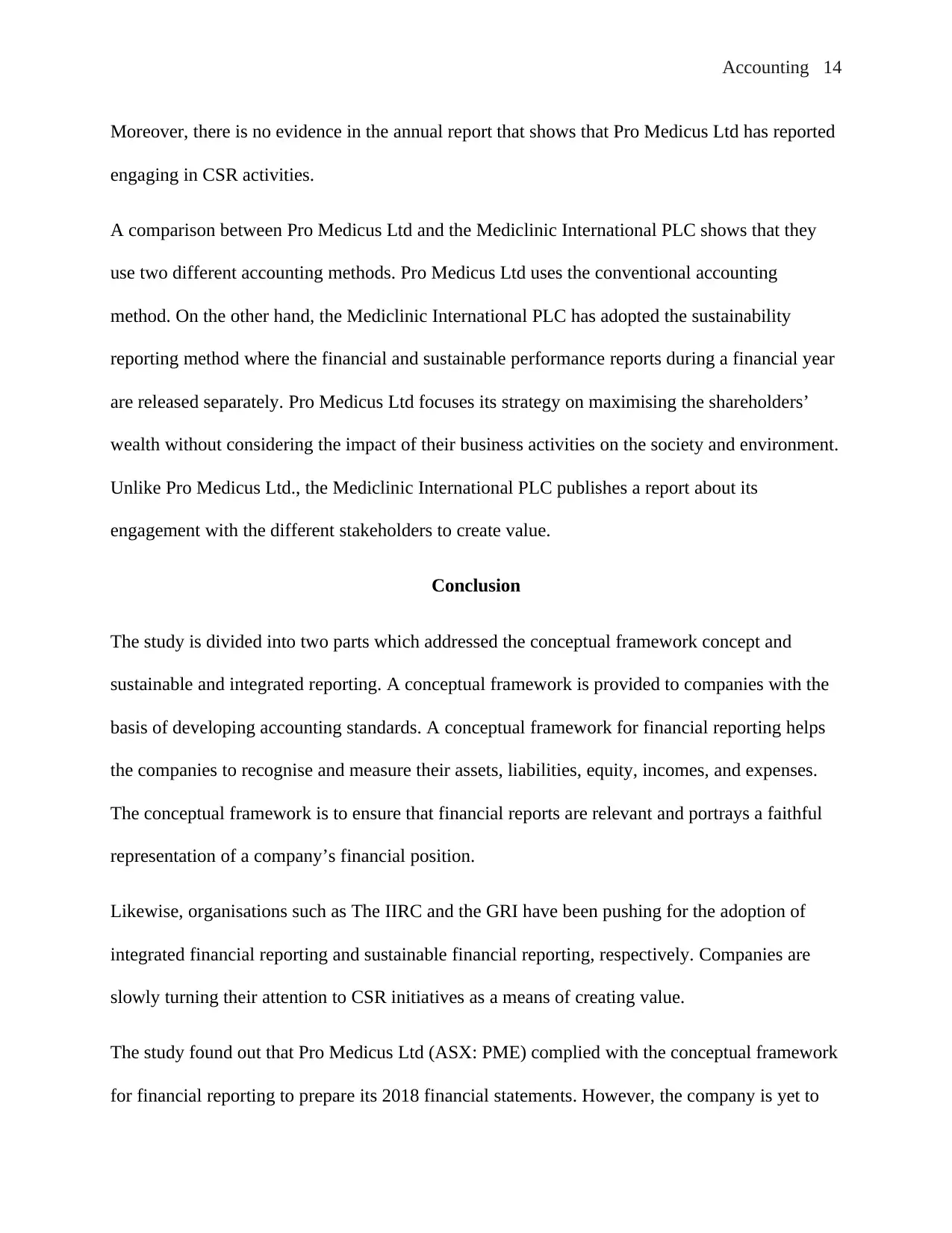
Accounting 14
Moreover, there is no evidence in the annual report that shows that Pro Medicus Ltd has reported
engaging in CSR activities.
A comparison between Pro Medicus Ltd and the Mediclinic International PLC shows that they
use two different accounting methods. Pro Medicus Ltd uses the conventional accounting
method. On the other hand, the Mediclinic International PLC has adopted the sustainability
reporting method where the financial and sustainable performance reports during a financial year
are released separately. Pro Medicus Ltd focuses its strategy on maximising the shareholders’
wealth without considering the impact of their business activities on the society and environment.
Unlike Pro Medicus Ltd., the Mediclinic International PLC publishes a report about its
engagement with the different stakeholders to create value.
Conclusion
The study is divided into two parts which addressed the conceptual framework concept and
sustainable and integrated reporting. A conceptual framework is provided to companies with the
basis of developing accounting standards. A conceptual framework for financial reporting helps
the companies to recognise and measure their assets, liabilities, equity, incomes, and expenses.
The conceptual framework is to ensure that financial reports are relevant and portrays a faithful
representation of a company’s financial position.
Likewise, organisations such as The IIRC and the GRI have been pushing for the adoption of
integrated financial reporting and sustainable financial reporting, respectively. Companies are
slowly turning their attention to CSR initiatives as a means of creating value.
The study found out that Pro Medicus Ltd (ASX: PME) complied with the conceptual framework
for financial reporting to prepare its 2018 financial statements. However, the company is yet to
Moreover, there is no evidence in the annual report that shows that Pro Medicus Ltd has reported
engaging in CSR activities.
A comparison between Pro Medicus Ltd and the Mediclinic International PLC shows that they
use two different accounting methods. Pro Medicus Ltd uses the conventional accounting
method. On the other hand, the Mediclinic International PLC has adopted the sustainability
reporting method where the financial and sustainable performance reports during a financial year
are released separately. Pro Medicus Ltd focuses its strategy on maximising the shareholders’
wealth without considering the impact of their business activities on the society and environment.
Unlike Pro Medicus Ltd., the Mediclinic International PLC publishes a report about its
engagement with the different stakeholders to create value.
Conclusion
The study is divided into two parts which addressed the conceptual framework concept and
sustainable and integrated reporting. A conceptual framework is provided to companies with the
basis of developing accounting standards. A conceptual framework for financial reporting helps
the companies to recognise and measure their assets, liabilities, equity, incomes, and expenses.
The conceptual framework is to ensure that financial reports are relevant and portrays a faithful
representation of a company’s financial position.
Likewise, organisations such as The IIRC and the GRI have been pushing for the adoption of
integrated financial reporting and sustainable financial reporting, respectively. Companies are
slowly turning their attention to CSR initiatives as a means of creating value.
The study found out that Pro Medicus Ltd (ASX: PME) complied with the conceptual framework
for financial reporting to prepare its 2018 financial statements. However, the company is yet to
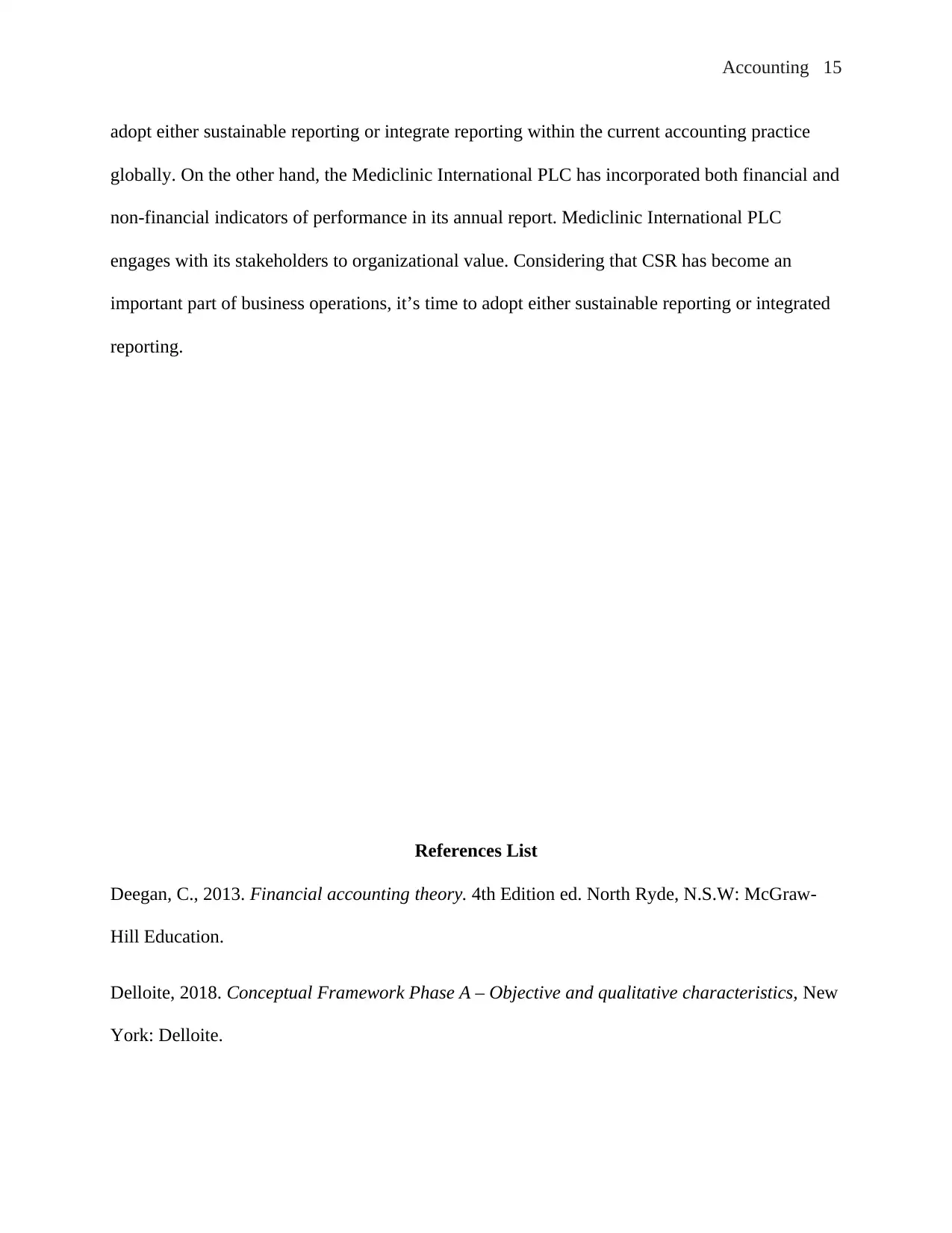
Accounting 15
adopt either sustainable reporting or integrate reporting within the current accounting practice
globally. On the other hand, the Mediclinic International PLC has incorporated both financial and
non-financial indicators of performance in its annual report. Mediclinic International PLC
engages with its stakeholders to organizational value. Considering that CSR has become an
important part of business operations, it’s time to adopt either sustainable reporting or integrated
reporting.
References List
Deegan, C., 2013. Financial accounting theory. 4th Edition ed. North Ryde, N.S.W: McGraw-
Hill Education.
Delloite, 2018. Conceptual Framework Phase A – Objective and qualitative characteristics, New
York: Delloite.
adopt either sustainable reporting or integrate reporting within the current accounting practice
globally. On the other hand, the Mediclinic International PLC has incorporated both financial and
non-financial indicators of performance in its annual report. Mediclinic International PLC
engages with its stakeholders to organizational value. Considering that CSR has become an
important part of business operations, it’s time to adopt either sustainable reporting or integrated
reporting.
References List
Deegan, C., 2013. Financial accounting theory. 4th Edition ed. North Ryde, N.S.W: McGraw-
Hill Education.
Delloite, 2018. Conceptual Framework Phase A – Objective and qualitative characteristics, New
York: Delloite.
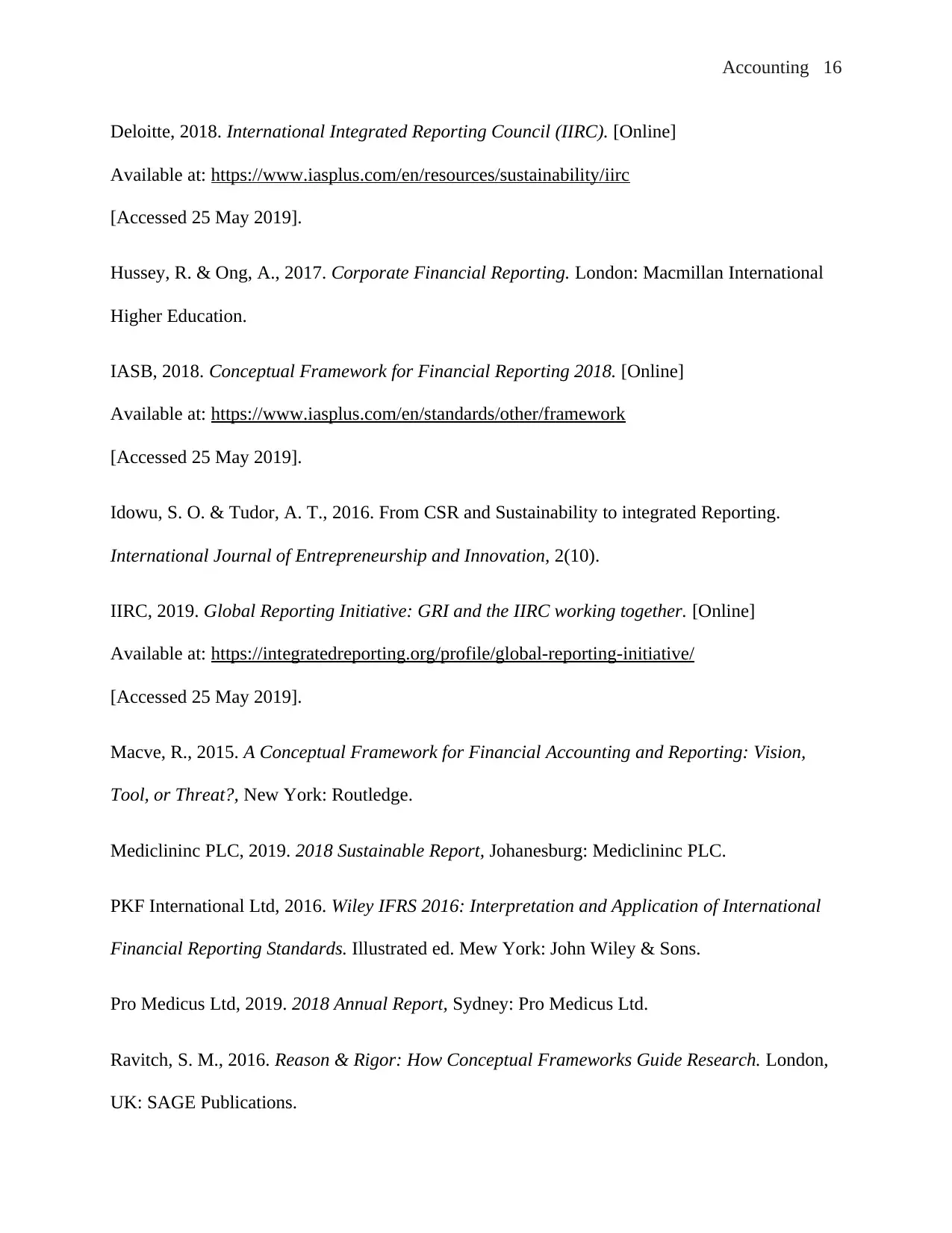
Accounting 16
Deloitte, 2018. International Integrated Reporting Council (IIRC). [Online]
Available at: https://www.iasplus.com/en/resources/sustainability/iirc
[Accessed 25 May 2019].
Hussey, R. & Ong, A., 2017. Corporate Financial Reporting. London: Macmillan International
Higher Education.
IASB, 2018. Conceptual Framework for Financial Reporting 2018. [Online]
Available at: https://www.iasplus.com/en/standards/other/framework
[Accessed 25 May 2019].
Idowu, S. O. & Tudor, A. T., 2016. From CSR and Sustainability to integrated Reporting.
International Journal of Entrepreneurship and Innovation, 2(10).
IIRC, 2019. Global Reporting Initiative: GRI and the IIRC working together. [Online]
Available at: https://integratedreporting.org/profile/global-reporting-initiative/
[Accessed 25 May 2019].
Macve, R., 2015. A Conceptual Framework for Financial Accounting and Reporting: Vision,
Tool, or Threat?, New York: Routledge.
Mediclininc PLC, 2019. 2018 Sustainable Report, Johanesburg: Mediclininc PLC.
PKF International Ltd, 2016. Wiley IFRS 2016: Interpretation and Application of International
Financial Reporting Standards. Illustrated ed. Mew York: John Wiley & Sons.
Pro Medicus Ltd, 2019. 2018 Annual Report, Sydney: Pro Medicus Ltd.
Ravitch, S. M., 2016. Reason & Rigor: How Conceptual Frameworks Guide Research. London,
UK: SAGE Publications.
Deloitte, 2018. International Integrated Reporting Council (IIRC). [Online]
Available at: https://www.iasplus.com/en/resources/sustainability/iirc
[Accessed 25 May 2019].
Hussey, R. & Ong, A., 2017. Corporate Financial Reporting. London: Macmillan International
Higher Education.
IASB, 2018. Conceptual Framework for Financial Reporting 2018. [Online]
Available at: https://www.iasplus.com/en/standards/other/framework
[Accessed 25 May 2019].
Idowu, S. O. & Tudor, A. T., 2016. From CSR and Sustainability to integrated Reporting.
International Journal of Entrepreneurship and Innovation, 2(10).
IIRC, 2019. Global Reporting Initiative: GRI and the IIRC working together. [Online]
Available at: https://integratedreporting.org/profile/global-reporting-initiative/
[Accessed 25 May 2019].
Macve, R., 2015. A Conceptual Framework for Financial Accounting and Reporting: Vision,
Tool, or Threat?, New York: Routledge.
Mediclininc PLC, 2019. 2018 Sustainable Report, Johanesburg: Mediclininc PLC.
PKF International Ltd, 2016. Wiley IFRS 2016: Interpretation and Application of International
Financial Reporting Standards. Illustrated ed. Mew York: John Wiley & Sons.
Pro Medicus Ltd, 2019. 2018 Annual Report, Sydney: Pro Medicus Ltd.
Ravitch, S. M., 2016. Reason & Rigor: How Conceptual Frameworks Guide Research. London,
UK: SAGE Publications.
Secure Best Marks with AI Grader
Need help grading? Try our AI Grader for instant feedback on your assignments.
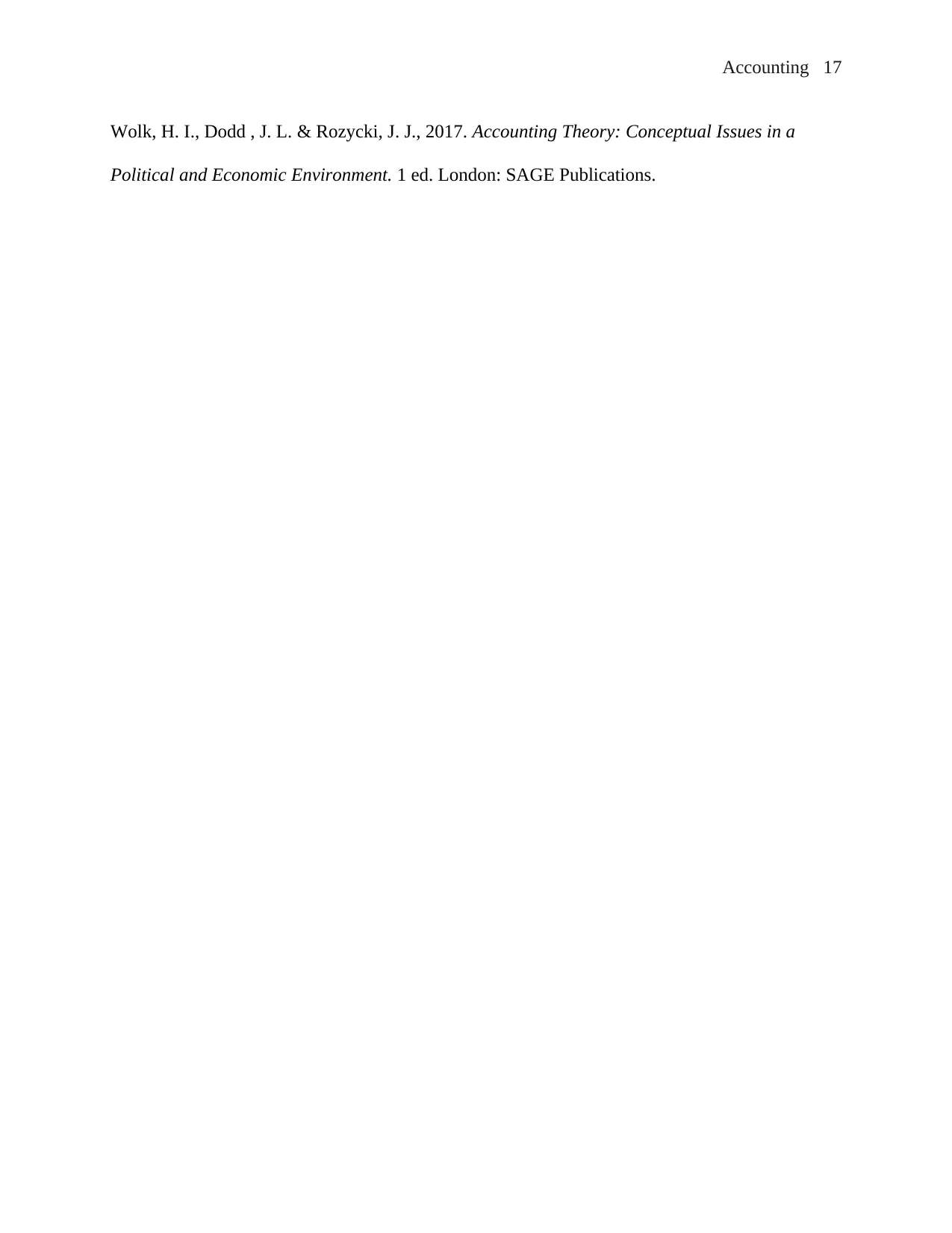
Accounting 17
Wolk, H. I., Dodd , J. L. & Rozycki, J. J., 2017. Accounting Theory: Conceptual Issues in a
Political and Economic Environment. 1 ed. London: SAGE Publications.
Wolk, H. I., Dodd , J. L. & Rozycki, J. J., 2017. Accounting Theory: Conceptual Issues in a
Political and Economic Environment. 1 ed. London: SAGE Publications.
1 out of 17
Related Documents
Your All-in-One AI-Powered Toolkit for Academic Success.
+13062052269
info@desklib.com
Available 24*7 on WhatsApp / Email
![[object Object]](/_next/static/media/star-bottom.7253800d.svg)
Unlock your academic potential
© 2024 | Zucol Services PVT LTD | All rights reserved.





